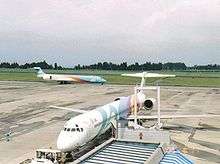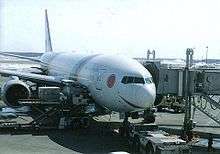Japan Air System
 | |||||||
| |||||||
| Founded | April 15, 1964 (as Japan Domestic Airlines) | ||||||
|---|---|---|---|---|---|---|---|
| Ceased operations | October 1, 2006 (merged into Japan Airlines) | ||||||
| Hubs |
Tokyo Haneda Airport Osaka Itami Airport | ||||||
| Secondary hubs |
Fukuoka Airport Chūbu Centrair International Airport New Chitose Airport | ||||||
| Focus cities |
Kansai International Airport Narita International Airport | ||||||
| Frequent-flyer program | JAS Mileage Service | ||||||
| Airport lounge | Rainbow Lounge | ||||||
| Alliance | One World | ||||||
| Subsidiaries |
Japan Air Commuter Hokkaido Air System Harlequin Air | ||||||
| Fleet size | 85 | ||||||
| Destinations | 46 | ||||||
| Company slogan | Good Speed Always | ||||||
| Parent company | Japan Air System Co., Ltd. | ||||||
| Headquarters | Haneda Airport, Tokyo, Japan | ||||||
| Website | www.jas.co.jp | ||||||
Japan Air System Co., Ltd. (JAS) (日本エアシステム Nihon Ea Shisutemu) (IATA: JD, ICAO: JAS, Call sign: Air System) was the smallest of the big three Japanese airlines. In contrast to JAL and ANA, its international route network was very small, but its domestic network incorporated many smaller airports that were not served by the two larger airlines. As an independent company, it was last headquartered in the JAS M1 Building at Tokyo International Airport (Haneda Airport) in Ōta, Tokyo. It has since merged with Japan Airlines.
JAS was famous for its variety of aircraft liveries; Amy Chavez of The Japan Times described the rainbow liveries as "abstract." Many of its color schemes in the 1990s were designed by film director Akira Kurosawa.[1]
The airline's slogan was "Good Speed Always".
History

Formation
The company was originally formed as Toa Domestic Airlines (東亜国内航空 Tōa Kokunai Kōkū) (TDA) in a merger between Toa Airways and Japan Domestic Airlines on May 15, 1971.[2] It adopted the Japan Air System (JAS) name on April 1, 1988.[2]
Start of international service
In 1988 Japan Air System began service from Narita to Seoul, South Korea, and by 1993 JAS was also flying to Singapore and Honolulu.[3] In 1995 the airline had 99 domestic routes, some international routes, 64 offices in Japan, one office in Seoul, and one office in Guangzhou, People's Republic of China.[2]
JAS entered into a partnership with Northwest Airlines in 1999 following several years of negotiations, allowing Northwest to codeshare on JAS domestic routes from Kansai Airport in Osaka and JAS to codeshare on Northwest flights between Japan and the US. On Northwest's fifth freedom flights between Japan and Asia, JAS was limited to codesharing on Northwest routes that JAS also had the authority to fly, such as Tokyo-Seoul.[4]
Boeing 777 livery design contest

In 1996, Japan Air System held a contest for designing the livery of the Boeing 777.[5] The youngest entrant was three years of age while the oldest was 84.[6] A total of 10,364 participants from 42 countries submitted entries.[6][7] The judges included Akira Kurosawa, Masuo Ikeda, Kenshi Hirokane, Yoshiko Sakurai, and Yusuke Kaji (梶 祐輔 Kaji Yūsuke).[6] Thirteen-year-old Masatomo Watanabe (渡部 真丈 Watanabe Masatomo), a male second year (Grade 8) junior high school student living near Chitose Airport, won the award.[8] The Japan Air System Boeing 777, painted in Watanabe's design, premiered in April 1997 to commemorate the 25th anniversary of Japan Air System.[9]
Merger with Japan Airlines
JAS and Japan Airlines announced their merger in November 2001. It was the first major airline industry realignment in Japan in three decades, and partly a consequence of the slump in worldwide air traffic following the September 11, 2001 attacks in the United States.[10] At the time, JAL had only a 25% share of the Japanese domestic air travel market, half that of rival All Nippon Airways, and saw the merger as a means of providing stronger competition to ANA domestically.[11]
JAS and JAL prepared an integrated timetable in August 2002. On October 2, 2002, they established a new holding company, Japan Airlines System (日本航空システム Nihon Kōkū Shisutemu), with Isao Kaneko as CEO. A new "Arc of the Sun" livery for the JAL group was announced in September 2002 and the first aircraft with the livery rolled out in November. On April 1, 2004, Japan Airlines (old JAL) changed its name to Japan Airlines International and Japan Air System (JAS) changed its name to Japan Airlines Domestic, officially ending the JAS brand.[12]
At the time of its integration into JAL, JAS operated Airbus A300, Boeing 777, McDonnell Douglas MD-80 and McDonnell Douglas MD-90 aircraft. Most continued flying as part of the JAL fleet, but three A300s were scrapped at Sendai Airport in 2002, while two others were transferred to Fly Air in Turkey.[13]
Corporate affairs


When Toa Domestic Airlines was originally established on May 15, 1971, its headquarters were located at the Japan Airlines Haneda Maintenance Center (羽田日本航空メンテナンスセンター Haneda Nihon Kōkū Mentanensu Sentā) at Tokyo International Airport (Haneda Airport) in Ōta, Tokyo. On February 28, 1972, its headquarters were moved to Mori Building No. 18 (第18森ビル Dai-jūhachi Mori Biru) in Minato, Tokyo.[14][15] On July 31, 1990, the headquarters moved from Mori Building No. 18 to Mori Building No. 37 (第37森ビル Dai-sanjūshichi Mori Biru),[16][17] located in Toranomon. On April 18, 1998, the head office moved to Haneda Maintenance Center 1 (羽田メンテナンスセンター1 Haneda Mentanansu Sentā, or JAS M1 Building) at Haneda Airport.[2][18][19] On August 11, 2003, as JAS was being merged into Japan Airlines, the JAS headquarters moved from Haneda Maintenance Center 1 to the JAL Building in Shinagawa, Tokyo.[20]
Destinations Prior to Merger
Domestic
Kantō region
Kansai region
- Osaka Prefecture
- Osaka International Airport (partially in Osaka Prefecture and partially in Hyogo Prefecture) and Kansai International Airport[23][24][25][27][30]
- Hyogo Prefecture
- Wakayama Prefecture
Chūbu region
Tohoku region
Chugoku region
Hokkaidō
- Asahikawa[24][27]
- Kushiro[24][27]
- Memanbetsu (now Ozora)[24][27]
- Obihiro[24][27]
- Sapporo (New Chitose Airport)[23][24][25][26][27]
Kyūshū
- Fukuoka Prefecture
- Kagoshima Prefecture
- Kumamoto Prefecture
- Miyazaki Prefecture
- Nagasaki Prefecture
- Oita Prefecture
Shikoku
Ryukyu Islands
International
Fleet
Before its merger with Japan Airlines, some of JAS fleet in history includes:


- Airbus A300 family[27]
- Boeing 767-200 (Never taken up and all -269 flown to Kuwait Airways.)
- Boeing 777-200[27][34]
- McDonnell Douglas MD-80/MD-90 family
- Douglas DC-9[34][35] (Retired prior to the merge with JAL)
- Douglas DC-10 [36] (Retired prior to the merge with JAL, sold to Northwest Airlines)
- NAMC YS-11 (later moved to subsidiary airlines)
Subsidiaries
Credit cards
In association with Visa, Mastercard, and Japan Credit Bureau JAS had "JAS Card" credit cards. In addition JAS had "Sky Merit" cards.[39]
Accidents and incidents
- July 3, 1971, Toa Domestic Airlines Flight 533: A NAMC YS-11A owned by Toa Domestic Airlines crashed into terrain, killing all 68 occupants.[40][41]
- April 18, 1993, Japan Air System Flight 451: A Douglas DC-9-41 of Japan Air System, flying from Nagoya to Hanamaki, crashed after the aircraft, caught by windshear, skidded off of the runway. All of the passengers and crew survived.[42]
Special liveries
Japan Air System, for a period, painted a Douglas DC-10 in a Peter Pan color scheme.[36]
See also
References
- ↑ Chavez, Amy. "Japan takes flight." The Japan Times. December 23, 2008. Retrieved on March 1, 2009.
- 1 2 3 4 "COMPANY INFORMATION." Japan Air System. November 6, 1999. Retrieved on January 13, 2009. "Headquarters: JAS M1 Bldg. 5-1 Haneda kuko 3-chome, Ota-ku, Tokyo 144-0041 Japan"
- ↑ "1993 - JAS (Japan Air System) Timetables, Route Maps, and History". Airchive.com. Retrieved 2014-03-01.
- ↑ "Northwest Airlines cements alliance with JAS". Flightglobal. 16 June 1999. Retrieved 17 July 2013.
- ↑ "The Boeing Company and Japan." Boeing. July 5, 2007. Retrieved on March 1, 2009.
- 1 2 3 "JAS [B777] Rainbow Design Competition." (Archive) Japan Air System. Retrieved on March 1, 2009.
- ↑ "The course of the competition." (Archive) Japan Air System. Retrieved on March 1, 2009.
- ↑ "It was a 13-year-old boy who gave JAS a fantastic present!." (Archive) Japan Air System. Retrieved on March 1, 2009.
- ↑ "Rainbow Design Competition/Presenting the result." (Archive) Japan Air System. Retrieved on March 1, 2009.
- ↑ Belson, Ken (13 November 2001). "Japan Airlines and Japan Air System Take Merger Move". New York Times. Retrieved 17 July 2013.
- ↑ "Japan Airlines, JAS Reported Near Merger". Associated Press. 12 November 2001. Retrieved 17 July 2013.
- ↑ "History of JAL". Japan Airlines. Retrieved 17 July 2013.
- ↑ "Japan Air System (JAS) Fleet Details and History - Planespotters.net Just Aviation". Planespotters.net. Retrieved 2014-03-01.
- ↑ "JAS 1971-1980." Japan Airlines. Retrieved on December 6, 2011. "[...]Japan Airlines Maintenance Center (9-1, 1-chome Haneda Airport, Ota-ku, Tokyo)" and "[...]Mori Building No. 18 (28 Nishikubo Akefunecho, Minato-ku, Tokyo)."
- ↑ "JAS 1971-1980." (Japanese) Japan Airlines. Retrieved on December 13, 2011. "[...]羽田日本航空メンテナンスセンター(東京都大田区羽田空港1丁目9番1号)" and "[...]第18森ビル(東京都港区西久保明舟町28番)"
- ↑ "1981-1990." Japan Airlines. Retrieved on December 6, 2011. "Moved JAS headquarters from Mori Building No. 18 to Mori Building No. 37."
- ↑ "1981-1990." (Japanese) Japan Airlines. Retrieved on December 13, 2011. "本社を第18森ビルから第37森ビルへ移転。"
- ↑ "JAS 1991-2000." Japan Airlines. Retrieved on December 6, 2011.
- ↑ "JAS 1991-2000." (Japanese) Japan Airlines. Retrieved on December 13, 2011. "虎ノ門第37森ビルから羽田メンテナンスセンター1へ。"
- ↑ "JAS 2001-2004." Japan Airlines. Retrieved on December 6, 2011.
- 1 2 "INTERNATIONAL TIMETABLE OCTOBER 1 - 31,1999."
- 1 2 3 4 5 6 "Month : 2001/2/1 - 2001/3/31 OKINAWA/AMAMIISLAND AREA." Japan Air System.
- 1 2 3 4 5 6 7 8 9 10 11 12 13 14 15 16 17 18 "Month : 2001/2/1 - 2001/3/31 KYUSYU AREA." Japan Air System.
- 1 2 3 4 5 6 7 8 9 10 11 12 13 14 "Month: 2001/2/1 - 2001/3/31 HOKKAIDO AREA." Japan Air System.
- 1 2 3 4 5 6 7 8 9 10 11 12 13 "Month : 2001/2/1 - 2001/3/31 TOHOKU AREA." Japan Air System.
- 1 2 3 4 5 6 7 8 9 10 11 "Month: 2001/2/1 - 2001/3/31 CHUGOKU/SHIKOKU AREA." Japan Air System.
- 1 2 3 4 5 6 7 8 9 10 11 12 13 14 15 16 17 18 19 20 21 22 23 24 25 26 27 28 29 "Month: 2001/2/1 - 2001/3/31 KANTO AREA." Japan Air System.
- 1 2 "Month: 2000/12/22 - 2001/1/8 KANSAI/KINKI AREA." Japan Air System.
- 1 2 "Month: 2000/12/22 - 2001/1/8 CHUBU/HOKURIKU AREA." Japan Air System.
- 1 2 3 4 5 6 "JAS International Timetable NOVEMBER 1,1999- MARCH 25,2000." Japan Air System.
- 1 2 3 4 5 "International Flight Information (Effective October 29, 2000?`March 24, 2001)." Japan Air System.
- 1 2 "COMPANY NEWS; Japanese Give Boeing $820 Million Order." The New York Times. June 30, 1993.
- 1 2 3 4 5 "Photo Gallery." Japan Air System.
- 1 2 "Japan Air System Accepts its First Pratt-Powered 777." PR Newswire.
- ↑ "Gallery" (November 7, 1996). Japan Air System.
- 1 2 Airliner Color History: McDonnell Douglas DC-10. 80.
- ↑ "2002/11/15 Interim Financial Information." Japan Airlines.
- ↑ "Japan Air System To Cut 1,000 Jobs ." Associated Press.
- ↑ "Card" (Japanese). Japan Air System. Retrieved on March 1, 2009.
- ↑ "Accident Database: Accident Synopsis 07031971". Airdisaster.com. 1971-07-03. Retrieved 2014-03-01.
- ↑ "ASN Aircraft accident NAMC YS-11A-217 JA8764 Yokotsu Mt". Aviation-safety.net. 1971-07-03. Retrieved 2014-03-01.
- ↑ "ASN Aircraft accident McDonnell Douglas DC-9-41 JA8448 Morioka-Hanamaki Airport (HNA)". Aviation-safety.net. Retrieved 2014-03-01.
External links
| Wikimedia Commons has media related to Japan Air System. |
- Archives of http://www.jas.co.jp/e_jashom.htm
- Archives of http://www.jas.co.jp/eng/index.htm
- Archives of http://www.jas.co.jp
- Gallery of JAS liveries
- A tale of many tails: the merger of Japan Airlines and Japan Air System makes perfect business sense, but commonality of equipment is a different matter. Air Transport World. April 1, 2003.
